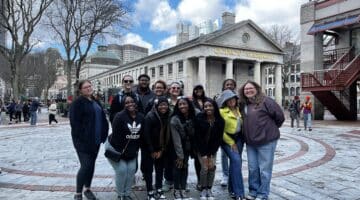Spanish Language Resources: 5 Ways to Practice Spanish Outside the Classroom

Learning a foreign language is so much more than an academic exercise. It opens doors to new people, cultures, and experiences. While learning grammar, conjugations, tense agreements and gendered pronouns are all certainly important elements of learning Spanish, language is ultimately a tool. Equipped with the ability to communicate with native Spanish speakers, an entire world of knowledge becomes available. Students can take what they’ve learned in the classroom and apply it to the world in which they live.
At ACIS, our mission is to empower educators to introduce their students to the world beyond the classroom and inspire the next generation of global citizens. Nothing excites us more than the opportunity for a student to make the connection between what they learn from their teachers and what they experience in the world at large.
Experience can be an extremely powerful teaching model. That’s why we’ve put together this list of 5 Ways to Practice Spanish Outside the Classroom:
1. Start/Join a Spanish Club
One of the easiest and simplest ways for students to practice their Spanish is by starting or joining a Spanish club. Meeting on a semi-regular basis to chat in Spanish about current events, culture or whatever else piques their interest will be an accessible and effective way for your students to practice their language skills. To make it a little more fun, they can introduce different Spanish or Latin American cultural elements to the gatherings. Meals at Spanish and Latin American restaurants, dance lessons, or music performances. Making the connection between what they’re learning in the classroom to all the vibrant culture the Spanish-speaking world has to offer will help them develop their passion for learning and foster more of a growth mindset.
2. Devour Spanish Culture
Perhaps the most fun way to practice Spanish is to soak up Spanish and Latin American culture. Museum exhibits, concerts, dance lessons, cooking classes and film screenings are all great activities to do as a group. Listening to Spanish language music, reading Spanish language books and newspapers, and watching Spanish language television and films are all extremely accessible ways to experience Spanish and Latin American culture on a day-to-day basis. The Spanish-speaking world is wide and diverse, so there’s no shortage of culture to consume!
3. Volunteer
There’s also no shortage of organizations that serve Spanish-speaking populations that are always looking for volunteers or part-time employees. Working or volunteering as a medical interpreter, health and family service worker, big brother/big sister, a companion for the elderly, or any other community-based role that serves Spanish speakers will be a great opportunity to help a community in need and enhance language skills. Depending on where you live there will most likely be non-profits and community organizations that are either specifically targeted at the Spanish-speaking community, or the community at large. If your school has a service component, you could include volunteerism as part of the core requirements for your class.
4. Spend Time in a Spanish Speaking Neighborhood
Students can find a neighborhood where Spanish is commonly spoken and immerse themselves in the local culture. Perhaps that’s hanging out at a particular coffee shop on a regular basis, or frequenting a dance studio or concert venue where Spanish language music and dance is commonly offered. Challenge your students to find ways to become active contributors to the Spanish-speaking community they seek out (not just tourists who drop in on occasion).
5. Travel!
And of course, the best time and place to practice any language is in the countries where it’s natively spoken. Whether it’s on a short vacation or an extended immersive trip, being in an environment where the language lives is always the best way to learn. Using their language skills in a home-stay setting, service learning project, navigating public transit or transactions with local merchants; each experience your students have using their language skills in that foreign environment will help build their confidence and foster an ever increasing growth mindset. There’s no greater motivation for learning than seeing the real-world application of all their coursework.
How do you encourage your students to practice Spanish outside the classroom? Let us know in the comments section below!










